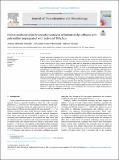| dc.contributor.author | Oyetade, Joshua | |
| dc.contributor.author | Machunda, Revocatus | |
| dc.contributor.author | Hilonga, Askwar | |
| dc.date.accessioned | 2024-05-08T09:15:33Z | |
| dc.date.available | 2024-05-08T09:15:33Z | |
| dc.date.issued | 2024 | |
| dc.identifier.uri | doi.org/10.1016/j.jpap.2024.100231 | |
| dc.identifier.uri | https://dspace.nm-aist.ac.tz/handle/20.500.12479/2609 | |
| dc.description | This research article was published in the Journal of Photochemistry and Photobiology 2024 | en_US |
| dc.description.abstract | Various integrated technologies have been investigated for the remediation of heavily polluted industrial dye
effluent. Also, more than 70 % of these dyes are known to be solely azo dyes used in the textile industry with
5–30 % presence in the effluent as loose dye molecules which are recalcitrant to treatment. These challenges led
to the investigation of energy-efficient processes (solar) and the fabrication of high-performance nano-photo-
catalysts for proficient photocatalysis of dye effluent while mediating the process with Fenton reagents. The
study fabricated nanopolymeric catalyst composites (P-AKT) via novel in situ coupling and impregnation of the
polyaniline (PANI) with surface-activated TiO2 NPs. This fabrication is aimed at developing a high-performance
catalyst with rapid and proficient photocatalytic activities to photons from sunlight irradiation. The photo-
catalytic process was mediated using a novel Fenton reagent to enhance the generation of radical species for dye
degradation. Various instrumental characterization methods were used to study the structural, molecular,
elemental, functional and optoelectronic properties of the fabricated nanocomposite photocatalysts. The result
reveals functional groups aiding dye-catalyst bonding and morphological interaction reveal a surface-activated
tetragonal crystalline mixture of anatase and rutile from TiO2
Nps embedded in the macromolecular chain of
PANI. It also reveals the optimal conditions of 20 mg dosage, 10 mg/L initial concentration with substantial
effectiveness at pH of 5 and 7. However, the most efficient photocatalyst recorded was P-AKT-2 % and P-AKT-3 %
having 95 % and 94 % efficiencies at 90 min of solar irradiation. The photocatalyst equally demonstrated its
capacity for effluent treatability up to 4 cycles of use | en_US |
| dc.language.iso | en | en_US |
| dc.publisher | Elsevier | en_US |
| dc.subject | Photodegradation | en_US |
| dc.subject | Photocatalysis | en_US |
| dc.subject | Photons | en_US |
| dc.subject | Composites | en_US |
| dc.subject | Effluent | en_US |
| dc.title | Fenton-mediated solar-driven photocatalysis of industrial dye effluent with polyaniline impregnated with activated TiO2-Nps | en_US |
| dc.type | Article | en_US |

